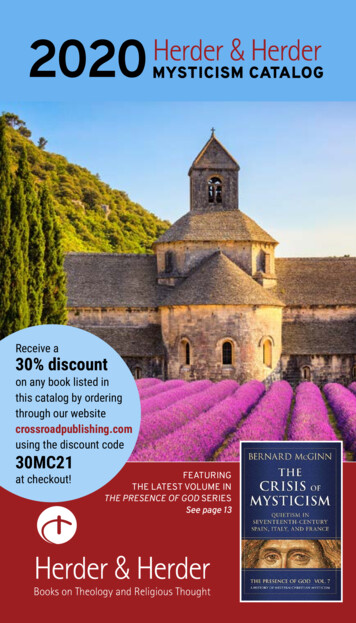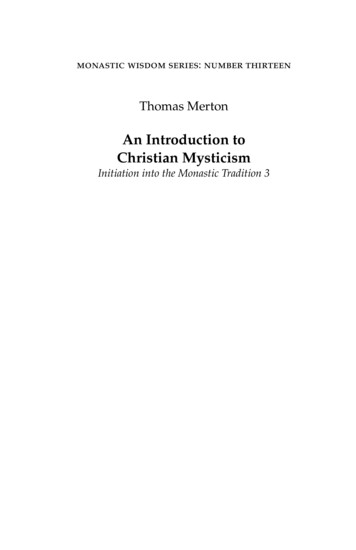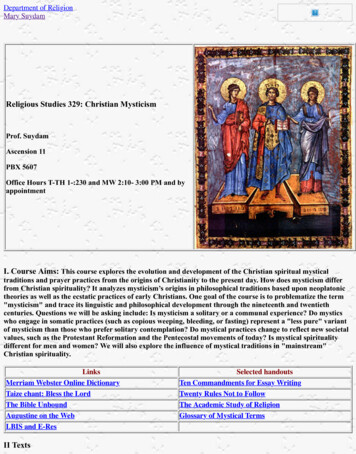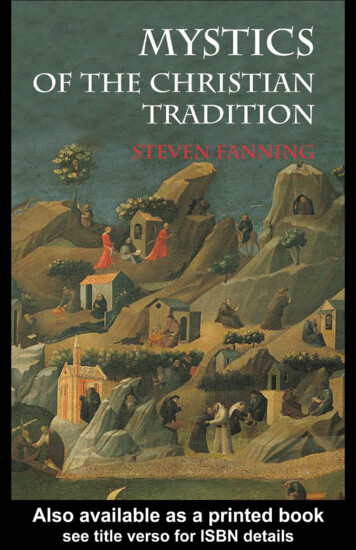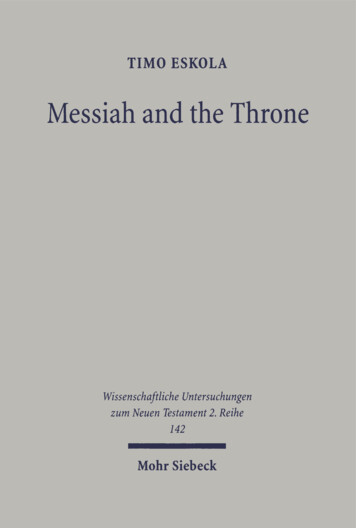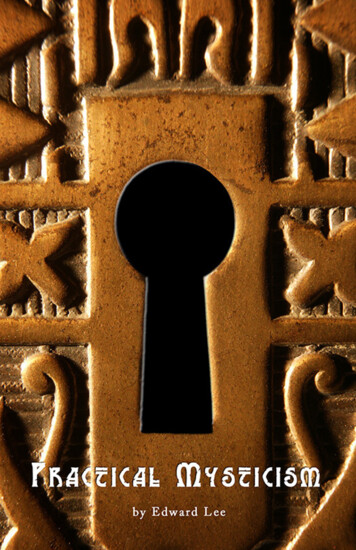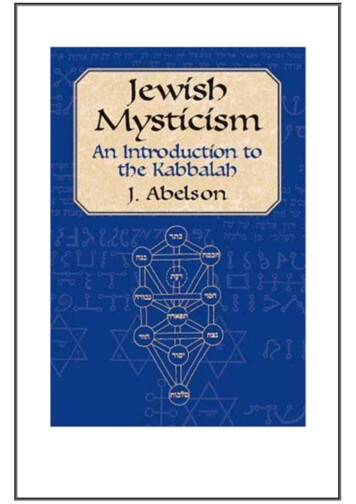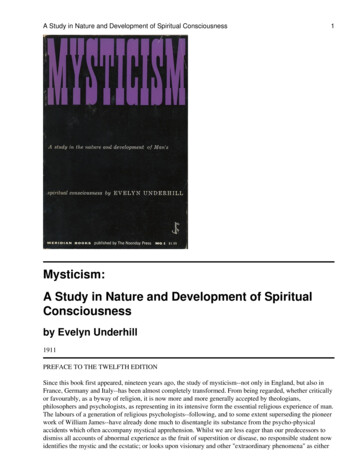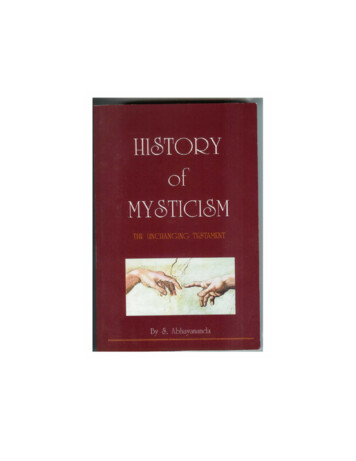
Transcription
History Of Mysticism
Other books by Swami Abhayananda:The Supreme SelfHistory of Mysticism: The Unchanging TestamentThe Wisdom of VedantaJnaneshvar: The Life And WorksDattatreya: Song of The AvadhutThomas á Kempis: On The Love of GodPlotinus: The Origin of Western MysticismMysticism And Science: A Call for ReconciliationThe Divine UniverseReflections On The SoulBody And SoulMystical Theology
HISTORY OF MYSTICISMThe Unchanging Testamentby Swami AbhayanandaATMA BOOKS
Newly Revised Twenty-fifth Anniversary Edition 2012Copyright 1987, 1994, 1996, 2009, 2012 by Swami AbhayanandaPublished and printed in the U.S.All rights reserved. No part of this book may be used or reproduced inany manner whatsoever without written permission except in the case ofbrief quotations embodied in critical articles and reviews. Address allcorrespondence to:Swami Abhayanandaat: abhayananda@bellsouth.netwebsite: www.themysticsvision.weebly.comLibrary of Congress Cataloging-in Publication DataAbhayananda, Swami, 1938History of mysticism : the unchanging testament /by S. Abhayananda. -- 5th ed.p. cm.Includes bibliographical references.ISBN 0-914557-21-1 (pbk.)1. Mysticism--History. I. Title.BL625.A297 1996291.4’22’09--dc2095-35127CIP
ACKNOWLEDGEMENTSI wish to acknowledge my indebtedness, and offer my sincere gratitude, to the following publishersand authors for the use of brief quotations from their works:Basil Blackwell Publishers for quotations from Ancilla To The Pre-Socratic Philosophers, byKathleen Freeman, published by Harvard University Press.Beacon Press, for quotations from The Gnostic Religion by Hans Jonas.Bobbs-Merril Co., for quotations from Recollections Of Socrates by Xenophon, by Anna Benjamin.Chicago University Press, for quotations from Giordano Bruno And The Hermetic Tradition, byFrances A. Yates.Doubleday Anchor Books, for quotations from The Spiritual Heritage Of India, by SwamiPrabhavananda; The World Of The Buddha, and Zen Poems, Prayers, Sermons, Anecdotes,Interviews, edited by Lucien Stryck.Frederick Ungar Publishing Co., for quotations from The Vision Of God, translated by Emma G.Salter.George Allen & Unwin, for quotations from The Philosophy Of Ibn ‘Arabi, by Rom Landau,Grove Press, for quotations from Essays In Zen Buddhism (First Series), by D.T. Suzuki; andManual Of Zen Buddhism, by D.T. Suzuki.Harper & Row for quotations from The Nag Hammadi Library in English, ed. by James M.Robinson.Harper Torchbooks, for quotations from Meister Eckhart, A Modern Translation, by Raymond B.Blackney.ICS Publications, for quotations from The Collected Works Of John Of The Cross, translated by K.Kavanaugh & O. Rodriguez.Jewish Publication Society, for quotations from Selected Religious Poems Of Solomon Ibn Gabirol,translated by Israel Zangwill.Martinus Nijhoff, for quotations from Hierarchy And The Definition Of Order In The Letters OfPseudo-Dionysius, by Ronald Hathaway.Oxford University Press, for quotations from The Early Church Fathers, by Henry Bettenson, TheEssence Of Plotinus, by Grace Turnbull, and Tibet’s Great Yogi Milarepa, by W.Y. Evans-Wentz.Pantheon Books, for quotations from Teachings Of Ch’an Buddhism, by Chang Chung-yuan.Paulist Press(Missionary Society of St. Paul the Apostle in the State of New York), for quotationsfrom Philo Of Alexandria, translated by David Winston, Ibn Arabi: The Bezels Of Wisdom, byW.W.J. Austin, Meister Eckhart: Essential Sermons, by Edmund Colledge, O.S.A. & BernardMcGinn, and Fakhruddin Iraqi: Divine Flashes, by W.C. Chittock & Peter Wilson.Penguin Books, for quotations from The Upanishads, translated by Juan Mascaro, and TheBhagavad Gita, translated by Juan Mascaro.Princeton University Press, for quotations from Plato: The Collected Dialogues, by Edith Hamilton& H. Cairns.Rama Tirtha Pratisthan for quotations from In Woods of God-Realization edited by Narayan Swami.Ramakrishna-Vivekananda Center, for quotations from The Gospel Of Sri Ramakrishna, translatedby Swami Nikhilananda.The Random House Group for extracts from Manual of Zen Buddhism by D.T. Suzuki published byRider.Samuel Weiser, for quotations from Essays In Zen Buddhism (2nd Series), by D.T. Suzuki.Shrine Of Wisdom, for quotations from Mystical Theology And The Celestial Hierarchy, by theEditors of the Shrine Of Wisdom.Society For Promoting Christian Knowledge, for quotations from The Areopagite on The DivineNames And The Mystical Theology, translated by C.E. Rolt.United Nations Educational Scientific and Cultural Organization for quotations from SelectionsFrom the Sacred Writings Of The Sikhs, by Trilochan Singh, et al.; published by Allen & Unwin.University of Notre Dame Press, for quotations from Unity And Reform: Selected Writings OfNicholas Of Cusa, by John P. Dolan.Vedanta Press, for quotations from Narada’s Way Of Divine Love, by Swami Prabhavananda, HowTo Know God: The Yoga Aphorisms Of Patanjali, by Swami Prabhavananda, and Shankara’s TheCrest-Jewel Of Discrimination, by Swami Prabhavananda.
viiCONTENTSPrefaceixIntroduction .1I.Mystics of The Ancient PastPre-history Of Mysticism.6Vedic Hymnists.21Early Egyptians .28The Early Jews .31Upanishadic Seers .37Kapila .44The Bhagavad Gita.49The Taoist Sages .62The Buddha .72II.Mystics of The Greco-Roman EraThe Pre-Socratic Greeks.88Socrates And His Successors .95Zeno of Citium .108Philo Judaeus.109Jesus of Nazareth.115Early Christians.123The Gnostics.129The Hermetics .146Plotinus.150III.Mystics of The Early Middle AgesPseudo-Dionysius.164Narada .171Patanjali.176The Tantra .181Shankara.196Dattatreya .206Milarepa .217The Ch’an And Zen Buddhists.224The Sufis .239
viiiAl-Hallaj.245IV.Mystics of The Late Middle AgesJewish Mysticism .250Ibn Arabi .262Iraqi .267Rumi.272Jnaneshvar .276Medieval Christians .287Meister Eckhart .289Thomas á Kempis.298V.Mystics of The Modern EraNicholas of Cusa .308Juan de la Cruz .320Kabir.336Nanak .345Dadu .355Seventeenth And Eighteenth Century Mystics.367Sri Ramakrishna .369Ramana Maharshi.389Swami Rama Tirtha.400Twentieth Century Mystics .415Conclusion.419About The Author .429Notes .430Bibliography.438Illustrations.444
ixPREFACEI am one of those who have been privileged, by the grace ofGod, to experience the ultimate Truth of existence. This “mysticalexperience” occurred, for me, on the night of November 18, 1966. Sincethat time, I have easily recognized, by their various descriptions of it,those who have also directly experienced that absolute Truth. And it hasbecome abundantly clear to me that, over the course of man’s longhistory, many individuals of differing cultures, languages, and religioustraditions have known that same unitive experience. Contained in thisbook are the accounts of the lives and teachings of some of the bestknown of those individuals, for whom I feel great empathy andcomradery, as my own experience coincides with and confirms theirown. In fact, their experience is my experience; for all who haverealized the Truth have known that same eternal Self.The material contained herein presents no speculativephilosophy; it offers no metaphysical hypothesis. Rather, it is thecollected legacy of those who have experienced, first-hand, the unitiveTruth underlying all existence. It is a record of the voices of theillumined souls of the past, all of whom gave their hearts, their verylives, to sharing their transcendent knowledge with unborn humanity.And so, to the prospective reader, I say: mark well what you read here.This is no ordinary history of people, places and events; it is the secrethistory of man’s perennial journey on the ultimate Quest, where all thetravelers, arriving from widely diverse paths, arrive at the self-sameunitive Truth. It is really the greatest, the most thrillingly wonderful,story ever told. May it awaken you and inspire you to join the greatQuest.Swami Abhayananda
“Ask of those who have attained God; all speak the same word. .Allthe enlightened have left one message; .it is only those in the midst oftheir journey who hold diverse opinions.”—Dadu
INTRODUCTION1INTRODUCTIONMysticism is that point of view which claims as its basis anintimate knowledge of the one source and substratum of all existence, aknowledge, which is obtained through a revelatory experience during arare moment of clarity in contemplation. Those who claim to haveactually experienced this direct revelation constitute an elite tradition,which transcends the boundary lines of individual religions, cultures andlanguages, and which has existed, uninterrupted, since the beginning oftime. It is, as Aldous Huxley points out, the “perennial philosophy” thatresurfaces again and again throughout history in the teachings of thegreat prophets and founders of all religions.When we study the many speculative philosophies and religiouscreeds which men have espoused, we must wonder at the amazingdiversity of opinions expressed regarding the nature of reality; but whenwe examine the testimonies of the mystics of past and present, we arestruck by the unanimity of agreement between them all. Their methodsmay vary, but their ultimate realizations are identical in content. Theytell us of a supramental experience, obtained through contemplation,which directly reveals the Truth, the ultimate, the final, Truth of allexistence. It is this experience, which is the hallmark of the mystic; itgoes by different names, but the experience is the same for all.By many of the Christian tradition, this experience is referred toas “the vision of God”; yet it must be stated that such a vision is notreally a “vision” at all in the sense in which we use the word to mean theperception of some ‘thing’ extraneous to ourselves. Nothing at all isperceived in “the vision of God”; rather, it is a sudden expansion, ordelimitation, of one’s own awareness which experiences itself as theultimate Ground, the primal Source and Godhead of all being. In that“vision,” all existence is experienced as Identity.We first hear of this extraordinary revelation from the authors ofthe Upanishads, who lived over three thousand years ago: “I haveknown that spirit,” said Svetasvatara, “who is infinite and in all, who isever-one, beyond time.”1 “He can be seen indivisible in the silence ofcontemplation,” said the author of the Mundaka Upanishad. 2 “There aman possesses everything; for he is one with the ONE.” 3 About fivehundred years later, another, a young prince named Siddhartha, who wasto become known as the Buddha, the enlightened one, sat communing
2HISTORY OF MYSTICISMinwardly in the forest, when suddenly, as though a veil had been lifted,his mind became infinite and all-encompassing: “I have seen the Truth!”he exclaimed; “I am the Father of the world, sprung from myself!”4 Andagain, after the passage of another five hundred years, another youngman, a Jew, named Jesus, of Nazareth, sat in a solitary place among thedesert cliffs of Galilee, communing inwardly, when suddenly he realizedthat the Father in heaven to whom he had been praying was his very ownSelf; that he was, himself, the sole Spirit pervading the universe; “I andthe Father are one!” he declared. 5Throughout history, this extraordinary experience of unity hasrepeatedly occurred; in India, in Rome, in Persia, in Amsterdam, inChina, devout young men and women, reflecting on the truth of theirown existence, experienced this amazing transcendence of the mind, andannounced to everyone who would listen that they had realized the truthof man and the universe, that they had known their own Self, and knownit to be the All, the Eternal. And throughout succeeding ages, theseannouncements were echoed by others who had experienced the samerealization: “I am the Truth!” exclaimed the Muslim, al-Hallaj; “My Meis God, nor do I recognize any other Me except my God Himself,” saidthe Christian saint, Catherine of Genoa. And Rumi, Jnaneshvar,Milarepa, Kabir and Basho from the East, and Eckhart, Boehme andEmerson from the West, said the same.These assertions by the great mystics of the world were not madeas mere philosophical speculations; they were based on experience anexperience so convincing, so real, that all those to whom it has occurredtestify unanimously that it is the unmistakable realization of the ultimateTruth of existence. In this experience, called samadhi by the Hindus,nirvana by the Buddhists, fana by the Muslims, and “the mystic union”by Christians, the consciousness of the individual suddenly becomes theconsciousness of the entire vast universe. All previous sense of duality isswallowed up in an awareness of indivisible unity. The man whopreviously regarded himself as an individualized soul, encumbered withsins and inhabiting a body, now realizes that he is, truly, the oneConsciousness; that it is he, himself, who is manifesting as all souls andall bodies, while yet remaining completely unaffected by the unfoldingdrama of the multiform universe.Even if, before, as a soul, he sought union with his God, now,there is no longer a soul/God relationship. He, himself, he now realizes,is the one Existence in whom there is neither a soul nor a God, but onlythe one Self, within whom this “imaginary” relationship of soul and God
INTRODUCTION3manifested. For him, there is no more relationship, but only the eternaland all-inclusive I AM. Not surprisingly, this illuminating knowledge ofan underlying ‘I’ that is the Soul of the entire universe has a profoundlytransformative effect upon the mind of those who have experienced it.The sense of being bound and limited to an individual body and mind, setin time and rimmed by birth and death, is entirely displaced by thekeenly experienced awareness of unlimited Being; of an infinitely larger,unqualified Self beyond birth and death. It is an experience, whichuniquely and utterly transforms one’s sense of identity, and initiates apermanently acquired freedom from all doubt, from all fear, from allinsecurity forevermore. Little wonder that all who experience suchliberating knowledge wish to share it, to announce in exuberant song toeveryone who will hear that, through the inner revelation of wisdom,“You shall know the truth, and the Truth will make you free!”If we can believe these men, it is this experience of unity, whichis the ultimate goal of all knowledge, of all worldly endeavor; thesummit of human attainment, which all men, knowingly or unknowingly,pursue. It would seem, then, a valuable task to study and review thelives and teachings of those who have acquired this knowledge. In thisbook, I have sought to present just such a study and anthology; it ispresented in an historical perspective in order to better view the longenduring tradition of mystical thought, and to reveal more clearly theunity underlying the diversity of its manifold expressions. Naturally, ithas not been possible to include every single instance of mysticalexperience, or to touch upon all the myriad extensions of mysticalknowledge, but I have attempted to tell the story of the lives andteachings of those who most intelligibly represent the mystical traditionas it has manifested throughout the ages. It is a story that begins long,long ago, in a past so remote that it is but vague and faint, beyond thereach of our straining vision, obscure in the hazy mists of time.
I. Mystics of The Ancient Past
6HISTORY OF MYSTICISMPRE-HISTORY OF MYSTICISMWhere, we must wonder, did mysticism begin? Who was thefirst to experience the transcendent vision? To these questions, there areno answers; but it is reasonable to assume that the experience of unity isas old as man himself, and occurred to a few searching souls even in themost primitive of times. The mystical experience of unity is entirelyindependent of advancements in learning or civilization. Indeed, itwould seem, if anything, to be more likely to occur in a simpler, less“civilized” environment, since such an experience requires a totallyinteriorized state of mind, undistracted by external stimuli. One caneasily imagine how spending one’s nights beside a fire under the canopyof the stars might enhance one’s contemplation of eternity. It is perfectlyreasonable, therefore, to suppose that seers of the Infinite existed even inthe very remotest unrecorded period of man’s history. Unfortunately,however, these ancient mystics are lost to us forever in the dark abyss oftime.Yet, while we do not possess the written testimonies of themystic sages of the dim past, there is some evidence for the antiquity ofmysticism to be found in the popular religious symbols, which havecome down to us as the artifacts and mythologies of primitive cultures.When we examine the mythologies of these earliest civilizations,especially those myths, which describe the origin of the cosmos, we finda curious similarity in the religious symbols used by widely separatedcultures. In almost every instance, we may discover the legend of anoriginal Father-God, whose first Thought or Word, symbolized in theform of a Mother-Goddess, is said to have given birth to all creation.In nearly every part of the globe these two have appeared, albeitwith many names. He, the Father-God, has been called An, Apsu, Huan,Prajapati, Purusha, Yahweh, El, Tem, Atmu, Ptah, Ra, Shiva, Brahman,Dyaus, Zeus, Vishnu, Ahura Mazda, Ch’ien, and Tao, among countlessother names. He is the absolute Stillness, the pure Consciousness, theunclouded Mind, the unmanifest Ground, who exists as the substratumupon which all this universe is projected. Likewise, in nearly everyrecorded mythology, we find the Mother-Goddess; She has been calledInanna, Isis, Shakti, Kali, Devi, Chokmah, Durga, Maya, Teh, Cybele,Athena, Astarte, Mylitta, Tara, Juno, Prthivi, Freia, Sophia, Prakrti,Semele, Ishtar, and many, many other names as well. She is the creative
PRE-HISTORY OF MYSTICISM7effusion of the Father; She is Mother Nature, the creative, manifestoryPower of the Father-God, manifest as the entire cosmos.In order to understand the vision of the earliest seers andmythologizers, we must look beyond the various names given to thisprimordial Pair, and try to grasp the meaning behind the words andmyths. The reason for the similarity of view among the various primitivecultures is that the Reality, which their pictorial symbols are contrived torepresent, is the common and universal Reality experienced in themystical vision, a Reality that is the same for all who “see” It. Scholarswho know nothing of the experience of unity postulate some culturalinterchange to account for such similarities between the various primitivecosmologies, or postulate an “archetypal memory” from which thesemany identical images supposedly arose, it never dawning on them thatthe direct knowledge of the one Absolute and Its projection of theuniverse is an actual experience common to all seers of all times.In this “vision” or “union,” the mind is somehow privileged toexperience itself as the eternal Consciousness from which the entireuniverse is projected. It knows itself as the unchanging Ground, orAbsolute, and the world as Its own projected Thought or Ideation. Theindividual who contacts, through prayer or deep meditation, thatuniversal Consciousness, experiences It as his (or her) own identity. He(or she) realizes, in those few moments, that he (or she) is indeed nothingelse but that one Being manifest in a singular individual form; and thatall this universe is the manifestation of that one Being, flowing forthfrom It as a wave of love streams out from a loving heart.One who has known It sees clearly that this mysticallyexperienced Reality has two distinct aspects; It is the pure, eternal One,beyond motion or change; and It is also the world-Thought, whichemanates from It, like the rays of a Sun, or the thoughts of a Mind. Inthis clear realization of Reality, the mind, while knowing itself as theundifferentiated Absolute, experiences concurrently the projection andreabsorption of the universe in a continuous cycle of outflowing andreturning. The universal manifestation appears and disappears in a cyclicrhythm extending over eons of our temporal reckoning, but the eternalAwareness, along with Its manifestory-Power, never changes. It is everimmersed in Its own bliss.So difficult is this two-in-One to speak of—since It cannot bespoken of without differentiating the two aspects, and making It appearto be two when It is always One—that the ancient seers tended tocharacterize the two aspects as male and female complements. In their
8HISTORY OF MYSTICISMattempts to explain this ineluctable duality-in-Unity, the seers of earlycultures relied upon pictorial symbols—such as the yin-yang symbol ofthe Chinese, or depicted the projection of the world of matter upon theAbsolute in anthropomorphic or animistic images. In nearly every suchinstance, the unmanifested Absolute was depicted as Male, and Itsprojected image-Power, co-existent with It, was regarded as Female. Heis the Father-God, the one Mind, the ultimate Source and Controller; butShe, His projected “Thought” is the Creatrix, the Mother-Power fromwhom all creation flows.That these two aspects of Reality should be so commonlysymbolized as male and female should not surprise us; for what betterpair of symbols can be imagined to represent the duality-in-Unityexperienced by the mystic than the two sexes who, while retaining theirindividual characteristics, are joined as husband and wife, forming anindivisible unit? The human male seems an apt symbol for theimmovable Absolute, the unchanging Consciousness, who witnesses, asthe subjective Self, the drama of universal manifestation. He representsthe Absolute in mythology as the wise and just Father and King, aloofand impersonal, the pillar of strength, governance, and protection. Thehuman female seems equally well suited to symbolize the creative Force,which emanates from the witnessing Self. She is the Womb of Naturefrom whom all life is born; She is the Source and Nourisher, and She isalso the object of desire. She represents the manifestory-Power inmythology as the ever-young maiden, the warm and tender Mother, theGiver of mercy, and the Fountain of all beauty and grace. Perhaps, insome mysterious way, these two—the human male and female—reallyare representative images, or manifestations, of the two complementaryaspects of the one Divine Reality.Evidence exists to show that, by the 3rd millennium B.C.E., andno doubt long before that, worship of a transcendent Father-God andMother (Nature) Goddess was widespread. The genuine mystics, theseers of Unity, were no doubt few then, as they are today, but there isrepeated evidence in the Creation myths of Egypt, Assyria, and Babylonthat such seers did exist. In the cosmologies of many of these earlycivilizations we find the common conception of the One Reality asconsisting of two aspects: the eternally transcendent Mind, and thedynamically creative Thought, which is responsible for the formation andsubstance of the relative world. Representing this creative Energy in the3rd millennium B.C.E., the Sumerian Goddess, Inanna, is made to say:“Begetting Mother am I. Within An (the Father-God) I abide, and no
PRE-HISTORY OF MYSTICISM9one sees me.” 1Since She, the Mother, is actually the manifestory-Power of theFather, and therefore indistinguishable from Him, they are frequentlypictured together, locked in an inseparable embrace; two, yet inextricablyOne. As we shall see, this mythic image of the Father-God and Hisubiquitous Consort is one which recurs again and again in themetaphysical formulations of all cultures. It is this recurring conception,which hints to us of mystical experience as the common origin.When we delve even further backward, into the upper Paleolithicera (ca. 35,000-9,000 B.C.E.), we find it difficult to imagine how onemight have communicated mystical experience in that time, long ago,even to one’s peers, considering the limited language skills of thepeoples of that time. But the challenge of communicating it to futuregenerations without the benefit of a written language was even moreimmense. The transcendent Absolute is beyond even the most eloquentspeech; how then was one to represent It in myth or legend?Here is one possible answer: Let us suppose that manythousands of years ago some nameless mystic told his comrades of hisexperience of the great Unity. And, for century after century, that talewas passed down orally as an authentic description of the origin andbeginning of all things; until, around 700 B.C.E., it finally appeared inwritten form as an allegorical tale, or myth, of creation. Here is that taleas it appears in the Brihadaranyaka Upanishad:In the beginning, there was only the Self. . Hereflected, and saw that there was nothing but Himself,whereupon he exclaimed, “I am” (Aham). Ever since, He hasbeen known within as “I.” Even now, when announcingoneself, one says, “I am .,” and then gives the other namethat one bears.He was afraid. Even today, one who is alone isafraid. But then he realized, “Since there is nothing else butmyself, what is there to fear?” It is only from [the presenceof] a second [entity] that fear need ever arise. However, hewas still unhappy. Even today, one is unhappy when alone.He desired a mate. And so he took on the form of a being thesize of a man and woman joined in a close embrace; and thenHe separated into two individuals: a man and a wife.Therefore, as the sage Yajnavalkya has declared, this body, byitself, is like half of a split pea. [In order to
Other books by Swami Abhayananda: The Supreme Self History of Mysticism: The Unchanging Testament The Wisdom of Vedanta Jnaneshvar: The Life And Works Dattatreya: Song of The Avadhut Thomas á Kempis: On The Love of God Plotinus: The Origin of Western Mysticism Mysticism A
